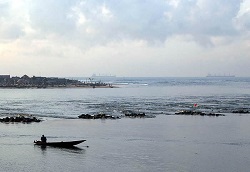Ouémé Delta
|
|
Ouémé is the largest River of Benin Republic. Its main course is about 510 km long. It takes it source in the Tanéka Mountains in the Department of Atacora and receives two main tributaries, Okpara (200 km) and Zou (150 km). The Ouémé Delta is the most important of the two Benin deltas. This delta is sustained by both two rivers (Ouémé and Sô), and includes a lake, a lagoon and a channel to the sea. The delta is classified as a Ramsar site (1018) known as Basse Vallée de l'Ouémé, Lagune de Porto-Novo, Lac Nokoué. The Delta complex is facing challenges due to population pressure, unsustainable management and climate change. |
General characteristics
• Continent: Africa
• Location: 8° 15' and 6° 33' N and 2° 00' and 1° 50' Est
• Delta area (km2): 9 000
• Major Cities: Abomey Calavi, Cotonou, Seme Kpodji, Porto Novo
• Basin area (km2): 49 256
• River length (km): 510
• Average rainfall (mm/y): 1160
• Maximum rainfall (mm/y): 1587
• Minimum rainfall (mm/y): 743
• Annual average discharge (m3/s): 170
• Maximum discharge (m3/s): 1175
• Minimum discharge (m3/s): 0
Main issues in the Delta
Inappropriate space occupation and overexploitation
Inappropriate space occupation, land reclamation and overexploitation of the delta resources are a worrying issue. Space occupation in the Ouémé delta has caused great concerns related to the demographic and urbanisation pressures. Fisheries and fish reproduction sites are multiplied on the water plans without appropriate regulation, ignoring navigation network. This situation generates conflicts among fishermen and other users of the delta, hampering the implementation of sustainable management.
Flooding, coastal erosion and pollution
Pressures and impacts from flooding and pollution are high in the Ouémé delta. The sea level rise and water regime modifications due to a combination of climate change and the unsustainable management of water resources have resulted in increasing flooding and coastal erosion in the delta. These developments along with populations’ displacements, cultural change due to habitat destruction, high urbanisation levels, perturbations of socioeconomic activities as well as local knowledge management, cause life to be constraining in the delta.
Moreover, flooding together with the inflow of untreated sewage and other sanitation problems due to high demographic growth associated with increased agrochemical use and oil spills in the delta are responsible for high environmental pollution, eutrophication and public health problems.
